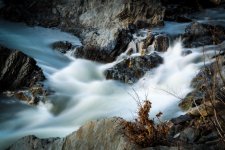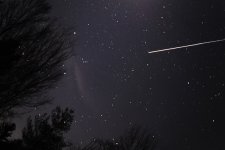I want to learn how to take long exposures, I purchased a set of ND filters for daytime. One thing I noticed is that the longer I kept the shutter open, the longer it took to appear on my display screen. Is this normal? I have a D5200. I tried one for about a minute and it took about 30 seconds to show up. I can imagine if I do star trails and keep it open for an hour. Any help on taking long exposures would be great. Thanks
You are using an out of date browser. It may not display this or other websites correctly.
You should upgrade or use an alternative browser.
You should upgrade or use an alternative browser.
First Time Trying Long Exposures
- Thread starter Smoke
- Start date
randyspann
Senior Member
Hi Smoke - do you have "long exposure NR" (noise reduction) turned on? If you do, the camera creates a "black mask" to subtract noise from the shot. This takes exactly the same length of time that the exposure took. The idea is for the camera to get the "noise footprint" at the time of exposure and use that to reduce noise. The alternative would be to turn that setting off and check results (you could then see if post processing gives you an acceptable result.)
That's one possible answer to your question.
That's one possible answer to your question.
Last edited:
Scott Murray
Senior Member
It all depends on the speed of your cards, when I use slow cards in my D800E they take ages (30sec exp = 30sec processing) but with my fast CF card its a second. I will be trialling longer exposures this Thursday/Friday with long exposure NR on for milkyway shots as it creates a black photo then takes away any noise. Will be interesting to see how it works.
BackdoorArts
Senior Member
So if I understand what you are saying.....if I take a 1 hour exposure, it will take an hour to display on the LCD screen? Wow!
That's what it will do - which is why I turn it off.
MartinCornwall
Senior Member
Unless you are in a proper dark site area an hour long exposure will suffer from bad light pollution as well as some serious noise. For star trails you are much better off taking multiple 30secs (depends on light pollution levels) and stacking them in a free program called StarStax. Using this method you turn off Long Exposure NR as this will leave gaps in the trails whilst processing the NR. The amount of noise from a 30 sec exposure is quite low and the stacking process evens out any noise as well.
randyspann
Senior Member
One problem with long exposures is noise. I've been experimenting with using a ND3 filter to get the exposure to between 1/2 and 1/8th second. Then take continuous shutter exposures (multiply the the shutter speed times number of exposures to get the long exposure duration you want), and then use stacking software to "stack" the images. Does a great job of eliminating noise and getting sharp focus. This one is 28 exposures, stacked with LR/Enfuse. (Lightroom/Enfuse)



